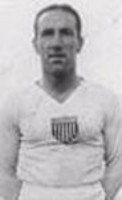

It may simply have been protecting himself. It may perhaps have been a Scot, used to what he interestingly called "organised football" and reacting to an owner, whose ethos he had grown to dislike. Whatever was the reason it proved to be the right move. The ASL clubs in the end stepped back as disorganisation began to affect their bottom lines and Bob Millar found his alternative position. He was appointed manager of the US national team, no doubt in the knowledge via the AFA and FIFA that there would in 1930 be the first World Cup, the professional version of Olympic football,and that if the the USA had a team and turned up it would play. At that moment it became Bob Millar's task to make precisely that happen, with Bart McGhee, who would continue more or less as the New York Nationals until 1931 except for a brief busman's holiday back in Philly at the Field Club in 1929, as an integral and ultimately crucial part of his plan. The US team would reach the semi-final of that first World Cup before being kicked off the park by a, shall we say, ruthless Argentina. Bob Millar would retire immediately on returning to US soil, in later life living in Kings in New York with his wife, Helen, and daughter, Mary, and working as a barman. He owned the Bob Millar Cafe, now the Mussels and More restaurant at 8001 5th Avenue, Brooklyn. And he would die in 1967 aged 76 on Staten Island. Bart McGhee would retire the following year in 1931 and return to Philadelphia. In 1930 he was married with two boys, a daughter followed, and living on South Reese St. in the centre of the city a short distance from where he had grown up. Like his father, a plasterer, when playing football, he was working in the building trade as a floor-layer, whilst clearly playing the game on the side. In 1940 he was recorded still as a labourer, in the year before his father's passing. And he himself would die aged 79 in 1979 still in Philadelphia, in the northern suburb of Norristown."I hereby advise you that I must refuse to continue as playing manager of the New York Nationals Football Club. I hereby tender my resignation, because to engage further in unsanctioned soccer football will materially endanger my status in organized soccer and will thereby affect my future livelihood as a professional soccer player. You have not lived up to the terms of my contract, which call for me to play and manage under the rules and regulations of the United States Football Association, and by forcing me to engage in outlaw soccer, you are breaking my means of gaining a living. I am compelled to seek a position in organised football."
